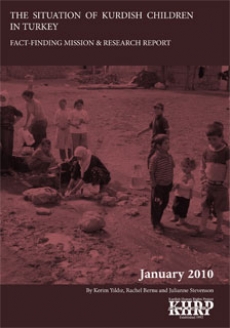| Éditeur : KHRP | Date & Lieu : 2010, London |
| Préface : | Pages : 158 |
| Traduction : | ISBN : 978-1-905592-29-6 |
| Langue : Anglais | Format : 148x210 mm |
| Thème : Politique |
|
Présentation
|
Table des Matières | Introduction | Identité | ||
 Versions:
THE SITUATION OF KURDISH CHILDREN IN TURKEY – FACT-FINDING MISSION & RESEARCH REPORT There are an estimated 15 million Kurds in Turkey. Comprising 23 per cent of the country’s population, the Kurds are Turkey’s largest non-Turkish ethnic group. According to census data, one quarter of the Turkish population is under 15. Accurate figures for the percentage of children under 18 are difficult to find given that the Turkish census only aggregates demographic data according to those aged 0-14, 15-64 and 65 years and over. However the United Nations Children’s Fund (UNICEF), estimate that approximately 36 per cent of Turkey’s population is under the age of 19, and applying this percentage to the Kurdish population we can roughly estimate that there are around 5,400,000 or more Kurdish children aged 19 and under in Turkey. In line with the mandate of promoting and protecting human rights in the Kurdish regions, in 2004 the KHRP produced a report on the situation of Kurdish children in Turkey, which was developed from desk-based research. KHRP decided to follow up on this report in 2008 in order to assess what improvements, if any, had been made in the intervening period. | |||||
| 1. KURDISH CHILDREN IN TURKEY: A BACKGCKGROUND | ||||